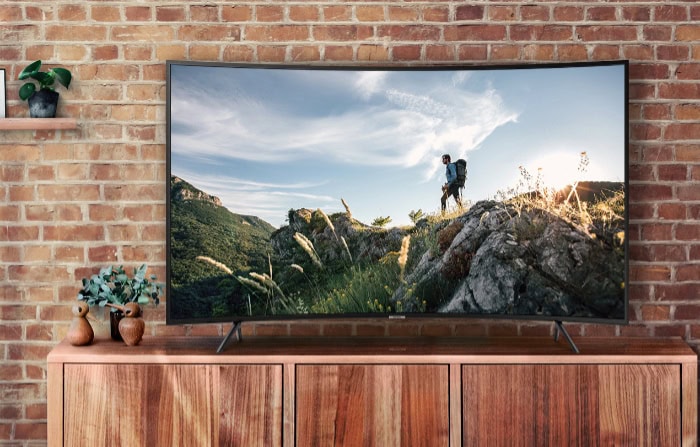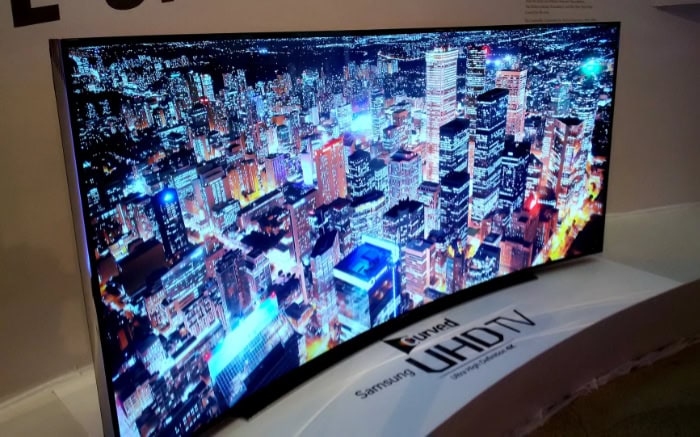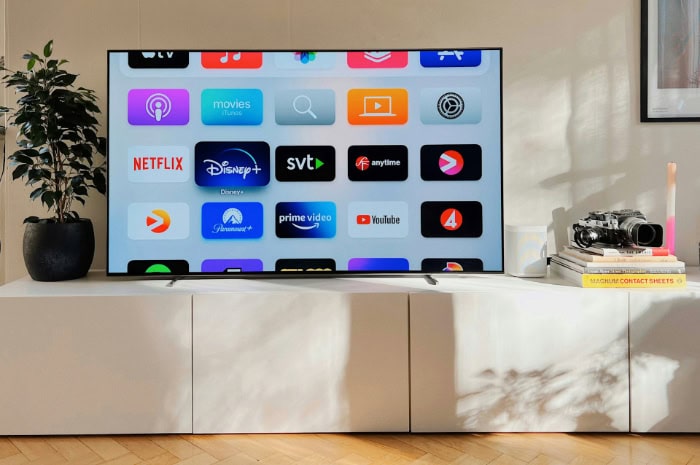OLED vs. UHD: What’s the Difference?

Staring at a wall of televisions in a brightly lit electronics store often leads to more questions than answers. You see “OLED” on one box and “UHD” on another, so it is natural to assume you must choose between them. That is actually a common mistake.
Defining OLED and UHD
Before picking a new television, shoppers must distinguish between the different categories of specifications. The acronyms often describe separate aspects of the display rather than competing technologies.
One term explains how the screen generates light, while the other indicates how many pixels create the image. Clarifying these definitions prevents the mistake of comparing unrelated features.
The Definition of OLED
OLED stands for Organic Light-Emitting Diode. It refers to the physical hardware of the screen.
The specific mechanism that sets OLED apart is the self-emissive pixel. Each tiny dot on the screen generates its own light independently.
Standard LED or LCD televisions rely on a large backlight panel behind the screen to illuminate the image. An OLED screen does not require this backlight.
When the content demands black, the individual pixels simply switch off. This capability results in perfect black levels and high contrast.
Manufacturers reserve this technology primarily for flagship televisions, high-end monitors, and premium smartphones.
The Definition of UHD
UHD stands for Ultra High Definition. It acts as a standard specification for resolution.
The term defines the grid of pixels that make up the display, usually numbering 3840 horizontal pixels by 2160 vertical pixels. Consumers and marketers frequently use the term “4K” interchangeably with UHD because the horizontal pixel count approximates four thousand.
This specification dictates image sharpness and density, not the lighting method. A budget-friendly LED screen can meet UHD standards just as easily as an expensive professional display.
The label simply confirms that the screen provides four times the pixel count of an older 1080p High Definition screen.
The Source of Confusion
Retail environments and product boxes frequently create a false choice between these two terms. You might see a row of TVs labeled “Crystal UHD” sitting next to a model labeled simply “OLED.”
Such presentation suggests you must sacrifice resolution to get the better panel technology or vice versa. That is rarely the case.
The vast majority of OLED televisions currently on the market are also UHD 4K displays. You get both the self-emissive technology and the high pixel count in the same package.
The true decision usually involves comparing an OLED 4K TV against a standard LED 4K TV. The resolution remains identical in that scenario, so the difference lies entirely in picture quality and panel performance.
Picture Quality and Performance

Specifications on a box rarely tell the full story of how a television performs in a real living room. While numbers and acronyms define the hardware limits, the actual viewing experience depends on how those technologies handle light, motion, and color.
Comparing the visual output requires looking at how resolution creates clarity and how panel technology dictates the quality of that clarity.
Sharpness and Detail
UHD resolution fundamentally changes how clear an image looks, particularly on larger displays. The high pixel density of a 3840×2160 grid eliminates the jagged edges and visible pixel structure that often plagued older, large 1080p screens.
Viewers can sit much closer to a massive 65-inch or 75-inch screen without noticing any degradation in image quality. The picture remains smooth and cohesive even at intimate viewing distances.
It is important to remember that sharpness relates almost entirely to resolution and source content rather than the panel type. A standard LED television with UHD resolution will display the same number of pixels as a top-tier OLED TV with the same specifications.
If the goal is simply to see the texture of a football field or the fine print on a news ticker, both technologies deliver identical levels of detail. The panel technology does not change the pixel count; it only changes how those pixels are presented.
Contrast, Black Levels, and Color Depth
OLED technology differentiates itself most aggressively through contrast. Since every pixel operates independently, the screen can achieve perfect black levels by simply turning specific pixels off.
There is no light bleed from surrounding areas. This capability creates an infinite contrast ratio, making colors appear more vibrant and creating a sense of depth that other screens struggle to match.
When a scene shows a bright moon against a night sky, the moon is brilliant while the sky remains ink-black.
Standard UHD LED or LCD televisions operate differently. They rely on a backlight that illuminates groups of pixels.
Even with advanced local dimming features, these screens often struggle to block light completely in dark areas. This limitation often results in “blooming,” where a halo of light surrounds bright objects on a dark background, or “crushed blacks,” where shadow details get lost in a murky grey wash.
While high-end LED sets have improved significantly, they rarely match the pixel-level precision of an OLED panel in dark room environments.
Brightness, HDR, and Viewing Angles
Panel brightness serves as the main advantage for premium LED and QLED televisions. These screens use powerful backlights that can push peak brightness to extreme levels.
This intensity helps the TV overcome glare in sun-drenched rooms and makes High Dynamic Range (HDR) highlights dazzle. If a TV must compete with unshaded windows or bright overhead lights, a high-quality LED model often maintains a visible, punchy image better than its competitors.
OLED screens generally offer lower peak brightness, though recent advancements are narrowing the gap. They excel in other areas of performance, specifically viewing angles and motion.
An OLED image maintains its accuracy and color saturation even when viewed from the far side of a room. In contrast, many LED screens look washed out or shifted in color if the viewer is not sitting dead center.
Additionally, the instant pixel response time of OLED technology handles fast motion exceptional well, reducing the blur often seen during fast-paced sports or action sequences on slower LED panels.
Matching Technology to Usage Scenarios
Technical specifications often exist in a vacuum, but real-world usage varies wildly from person to person. A screen that looks perfect in a basement home theater might struggle in a sunroom during a Sunday afternoon football game.
Identifying your primary entertainment habits helps narrow down the choice between a premium OLED panel and a high-brightness UHD LED model.
Cinema and Movie Performance
For viewers who prioritize film, the immersive quality of the image usually takes precedence over everything else. Cinematic content often relies heavily on shadows, subtle lighting, and rich color palettes to set a mood.
OLED technology shines in this environment because of its ability to render true black. When a movie scene cuts to black, the room plunges into darkness, maintaining the suspension of disbelief.
The advantage of self-emissive pixels becomes especially apparent with widescreen content. Most films display with black bars at the top and bottom of the screen.
On an OLED, these bars are truly black and effectively disappear into the bezel. On many LED screens, these bars appear as distracting dark grey stripes due to backlight bleeding.
If you frequently watch movies in a dim or light-controlled room, the depth provided by OLED creates a picture that feels almost three-dimensional and true to the director's intent.
Broadcast TV, Sports, and Bright Rooms
Daily television usage often involves combatting sunlight, overhead lamps, and reflections. Watching the news in the morning or a football game on a Sunday afternoon requires a screen that can punch through ambient light.
High-end UHD LED or QLED televisions typically offer superior brightness output compared to OLEDs, making them the practical choice for living spaces with many windows. A bright LED screen ensures the image remains vibrant and visible even when the sun is shining directly into the room.
Sports fans also have specific needs regarding motion and seating arrangements. While OLED handles motion blur excellently, the sheer brightness of a quality LED set helps distinct colors, like the green of a field or the white of a jersey, pop during daytime viewing.
Furthermore, hosting large groups for big games usually means people are scattered around the room. While OLED has superior viewing angles, many modern LED panels now include wide-angle technology that serves a crowded room adequately without the premium price tag associated with large-format OLED panels.
Gaming Specs and PC Compatibility
Video games and computer usage demand performance metrics that passive video watching ignores. Gamers look for low input lag and fast response times to ensure their actions register instantly on screen.
OLED panels offer near-instant pixel response times, often under one millisecond, which virtually eliminates the “ghosting” or trailing effects seen behind fast-moving objects. Most modern UHD OLEDs also support variable refresh rates (VRR) and high refresh rates, making gameplay incredibly fluid.
However, using a TV as a PC monitor or for marathon gaming sessions introduces a specific durability concern. Static elements like news tickers, health bars in games, or the desktop taskbar can leave a permanent retention mark on an OLED screen if displayed for thousands of hours.
While manufacturers have implemented software tricks to mitigate this risk, it remains a physical possibility with organic materials. Users who plan to work on spreadsheets all day or play the same game with a static interface for years might find a standard UHD LED display to be the safer, longer-lasting investment.
Practical Buying Factors

Selecting a television involves balancing performance specifications with financial realities and physical constraints. While picture quality often drives the initial interest, the final decision typically relies on how much value a shopper gets for their money.
Price vs. Screen Size
Manufacturing costs create a distinct divide between these two categories. Producing organic self-emissive panels remains an expensive process, which keeps the price of OLED televisions significantly higher than standard LED models.
A shopper with a set budget often faces a direct trade-off between quality and quantity. For the price of a high-end 55-inch OLED, a consumer can often purchase a 75-inch or even an 85-inch UHD LED television.
This price disparity forces buyers to evaluate their priorities based on viewing distance. If the seating area is far from the wall, the immersion of a massive screen often outweighs the superior contrast of a smaller, more expensive panel.
A 55-inch screen might look technically perfect, yet it can feel underwhelming in a large open-concept living room. Conversely, for a small den or bedroom where the viewer sits close, the superior image quality of the OLED justifies the higher price per inch, as the lack of size is less noticeable.
Brand Tiers and Feature Availability
Major electronics manufacturers organize their product lines in a predictable hierarchy. The term “UHD” or “4K” usually appears on boxes ranging from entry-level bargain models to mid-range options.
These televisions provide the necessary resolution but often lack advanced processing power, premium build materials, or high-bandwidth connectivity. They serve viewers who want a sharp picture without paying for cinema-grade performance.
OLED models almost exclusively occupy the flagship position in a brand's lineup. Because manufacturers position these sets as premium products, they typically equip them with the best available technology.
Buying an OLED usually ensures access to superior sound systems, faster processors for upscaling lower-resolution content, and full HDMI 2.1 support for modern gaming consoles. While it is possible to find high-end LED TVs with these features, an OLED purchase guarantees the buyer is getting the top tier of that brand's engineering and smart TV capabilities.
Energy Consumption and Longevity
Operational costs and durability differ significantly between the two technologies. LED televisions generally consume a consistent amount of power because the backlight stays on regardless of the content.
OLED power consumption fluctuates based on what is on the screen. Displaying a bright white hockey rink requires the pixels to work at maximum intensity, drawing more power, while a dark space movie consumes very little energy.
Long-term ownership also requires different maintenance mindsets. LED-backlit screens are generally robust and resistant to wear, making them ideal for users who leave the TV on for background noise all day.
OLED panels use organic compounds that degrade over time, making them susceptible to image retention or “burn-in” if static images remain on screen for too long. While modern software features like pixel shifting help mitigate this risk, owners must still exercise care by not leaving news tickers or video game user interfaces displayed for hours on end.
A Step-by-Step Decision Guide
Choosing the right television requires synthesizing all the technical details into a practical checklist. While specifications provide a baseline for performance, the physical environment and personal habits of the viewer play a much larger role in satisfaction.
Assessing Room Environment and Lighting
The first step involves looking away from the screen and at the room itself. Lighting conditions dictate which technology will perform best.
If the intended room features large, uncovered windows that flood the space with sunlight, an OLED screen may struggle. The glass on OLED panels is often reflective, and the lower peak brightness can make the image hard to see during the day.
In such uncontrolled lighting environments, a premium UHD LED or QLED TV is the superior choice. These models can pump out enough light to overpower reflections and maintain visibility.
Conversely, if the room is a basement, a bedroom with blackout curtains, or a dedicated home theater space, lighting control is less of an issue. In these dimmer environments, the advantages of a bright LED screen vanish, and its flaws becomes more visible.
The greyish blacks of an LED panel stand out painfully in the dark. An OLED panel thrives here.
The perfect black levels create a stunning image that blends seamlessly into a dark room. Finally, measure the seating distance.
If you sit more than ten feet away, a massive 75-inch mid-range LED might offer a more immersive experience than a smaller, superior-quality 55-inch OLED for the same price.
Evaluating Content Types and Habits
Once the room is sorted, consider what actually plays on the screen. Different genres of content benefit from different attributes.
If the primary usage involves streaming blockbuster movies or prestige dramas like Game of Thrones, contrast and shadow detail are paramount. These viewers will notice and appreciate the cinematic quality of an OLED immediately.
The ability to render difficult dark scenes without pixelation or grey wash makes it the definitive choice for film enthusiasts.
Households that lean heavily on broadcast television, news, and sports generally find a high-quality UHD LED set more practical. The static banners on news channels pose zero risk to an LED panel, and the high brightness helps the green of a football field pop.
For gamers, the decision is more nuanced. Competitive players who demand the fastest possible reaction times will prefer the speed of OLED.
However, casual gamers who play for hours on end with static heads-up displays (HUDs) might prefer the peace of mind that comes with a burn-in-resistant LED screen.
Balancing Budget Against Features
The final filter is the wallet. High-end televisions require shoppers to rank their priorities because getting everything in one package is costly.
The most common trade-off occurs between size and picture quality. A specific budget might buy a top-tier 65-inch OLED or a mid-range 85-inch UHD LED.
If filling a large wall is the goal, the sheer scale of the 85-inch screen often provides a “wow” factor that a smaller, technically superior screen cannot match.
Consider three common buyer profiles to help visualize this balance. The “Cinephile” sacrifices screen size to afford an OLED, prioritizing color accuracy and black levels above all else.
The “Family Viewer” chooses a large, bright UHD LED, valuing visibility during the day and a screen big enough for movie night without worrying about kids pausing a video game for three hours. The “Value Seeker” likely ignores OLED entirely, opting for a budget-friendly UHD LED that offers 4K resolution and decent smart features, accepting that the blacks will be grey and the viewing angles narrow in exchange for saving money.
Conclusion
The debate between OLED and UHD is ultimately a misunderstanding of terms. As we have seen, these two concepts work together rather than against each other.
UHD simply refers to the 4K resolution standard that ensures a sharp image, while OLED describes the premium panel technology that delivers perfect contrast and color. Most modern OLED televisions are, in fact, UHD televisions, offering the best of both worlds in a single package.
The real choice lies between the self-emissive perfection of an OLED panel and the brightness and value of a standard LED-backlit screen.
Finding the right television does not require memorizing a spec sheet. It requires an honest assessment of your own living space and viewing habits.
A dark room dedicated to movie nights calls for the ink-deep blacks of an OLED, while a sun-drenched living room used for afternoon sports demands the powerful brightness of a high-end LED. By focusing on your specific environment and budget rather than chasing the latest buzzwords, you can confidently select a screen that will look great every time you turn it on.


